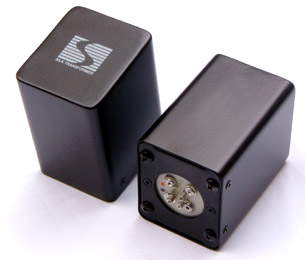|
1.
Low loss in plate load circuit.
Plate
load is needed to absorb energy generated by vacuum tube. Either resistance
or inductance can be the load of vacuum tube circuit since they both have
reactance to AC signal. The different is that reactance (from resistor)
has DC resistance up to 10 times or more of the same reactance from Inductor.
That's huge amount of energy loss when use resistor as load.
The
active load (active component) as used in SRPP and other circuits could
also form another type of plate load to vacuum tube circuit. It forms
constant high impedance load much like a cathode follower circuit on top
of the gain stage. (some say that it is much like push-pull circuit) The
benefit of high gain with wide bandwidth is now achieved with around ?
amount of raw energy consume in active load.
Plate
load not only served as energy absorber generated by vacuum tube, but
also served as signal generator.
As
far as hi-fi vacuum tube circuit is concerned plate load is either a resistor
type or active load type. Could that mean that they perform superior to
inductive load? The answer is definitely not. The cost and size of high
quality inductor to be used as plate load is enormous, around +100 times
of that resistor or active load. Transformer may also weight +1,000 times
more than a resistor. So it is very simple reason why 99.9% of all tube
designers adopt for resistor load.
Beside
from cost and weight issues, a good plate load inductor or transformer
is very difficult to wind even to big tube amplifier companies. If we
could deal with all of the commercial aspects that isolate the use of
plate load inductor, there are several benefits from using plate load
inductor as follows:
"
Inductor offers lower DC resistance than resistor of same loading. Typical
50 Henry 30mA may have internal DC resistance of around 300 ohms compare
to 5.0K ohms resistor load. This means that if 30mA of current has to
be drawn through a 5.0K ohms resistor, it will generate 150 voltage drop
across that resistor and that is around 4.5 watts heat dissipation. While
Inductor will drop only 9 volt equivalent to only 0.27 watt heat dissipation.
This is how the efficiency is gained from the use of plate load Inductor.
" Inductor offers highest gain obtainable from that gain stage while
the total gain of gain stage with resistor will depend on resistance.
The higher the resistance, the higher the gain with higher power loss
and higher output impedance.
" Inductor is a passive device that can store energy from power supply,
much like a reservoir, that has ability to supply transient energy to
load (in this case the vacuum tube itself). Resistor is also a passive
device but it could not store any energy within them so the fluctuation
of voltage to be feed to vacuum tube will vary more.
" We could eliminate a coupling device (usually capacitor) by introducing
second winding in the same core of plate load inductor, it becomes Interstage
transformer.
2. Elimination of coupling device
The
use of Interstage coupling offers the reduction of one major part in gain
stage; that's coupling capacitor. Coupling capacitor works against DC
(usually high voltage) to reach the grid of next stage but allow AC signal
(supposedly audio frequency) to pass. Coupling capacitor has always been
the subject of discussion regarding its tonal characteristic impurity
between each type and brand. Some audiophiles even notice the tonal different
of capacitors of same brand same type same value but different voltage
rating!
Secondary winding of Interstage transformer acts and behaves much like
the primary winding; that's to extract magnetic force and convert into
electrical signal. Turn ratio governs the proportion of voltage to be
extracted by secondary winding.
Magnetic coupling in Interstage transformer is the best energy transfer
mechanism for low frequency (audio frequency) that can be best viewed
same as the force working in most dynamic loudspeaker drivers.
3.
Better than Direct Coupling Method
Direct
coupling allow DC + AC signal to pass to grid of next gain stage. This
may look good but severe oscillation in subsonic region, hum and RF intermodulation
usually cause instability of the circuit due to its extreme bandwidth.
This will degrade the performance of the circuit considerably and cause
harsh/bright sound.
Successfully
designing and implementing Direct coupling circuit are very difficult.
If one claims that his Direct coupling circuit works good, the other one
may find it working differently if he try to copy the circuits by using
same parts and same schematic since bias adjustment and operating point
of next gain stage will depend largely on tolerance or parts and each
individual tube characteristic.
Direct
coupling with plate load resistor is out of discussion since it passes
the signal (left over energy from dissipating by load resistor) with appreciable
amount of loss already when compare with the use of plate load inductor.
Direct coupling with plate load inductor (Choke Load direct coupling)
is better but still pass energy left over from voltage drop across the
load, not the signal energy within the core to be transferred.
|
